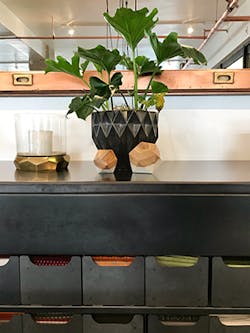Tangram Interiors’ DTLA Showroom Disrupts Traditional Office Design
Located in an older building in downtown Los Angeles, Tangram Interiors showroom fits in perfectly. Acting as both a display of Tangram Studio, Tangram Technology, and West Elm Workspace products as well as an office for Tangram’s downtown associates, it isn’t necessarily obvious whether it’s a location open to the trade. Unlike other dealer and manufacturer showrooms downtown, however, this site was chosen not only for its shabby-chic aesthetic but also because it’s so easy to visit; there isn’t a security desk to buzz you in or key pass needed to head up the elevator.
CREATING A PLACE OF COMFORT
The look is also unusual for a showroom with a massive SiliconCore display along one wall (created with individual panels that can be switched out, available through Tangram Interiors), a kitchen, and even a bar cart.
A full-wall display by SiliconCore and chunky, patterned sofa act as a “living room” to the showroom space.
“We don’t want you to come in here and look at product,” noted Paul Randall Smith, chief marketing officer for Tangram Interiors. “We want you to come and feel comfortable.” Pointing to the amenities, he stated millennials aren’t as comfortable attending events in restaurants; he’s seeing a move toward hosting gatherings in offices and showrooms. These changes are reflected in the Tangram location. “I’d say it’s a community space rather than using the word showroom,” he noted.
“This space is supposed to be a disruptor,” Smith added, referencing the ways in which new office layouts are changing the way we see workplaces.
A kitchen with a bar surface acts as both a place to work and to unwind.
ANCILLARY PRODUCTS HOLD THEIR OWN
Throughout the showroom there are a variety of plush chairs and other accessories that have become more commonplace in offices. Smith said that because of the resimercial trend in the industry, the company’s ancillary products sales have grown significantly over the past few years.
It makes sense. With open office layouts and the expectation that where you work is a home away from home, employees want to be able to both highlight their independent personalities in a work-appropriate manner and be able to find a comfortable chair to occasionally sit in while working.
Tangram’s open office space features two types of desking systems: a communal desk (a West Elm WORKSPACE product) where individual areas are delineated through the use of furniture and ancillary products, and a trio of sit-stand desks with rounded partitions created by Tangram Studio, a co-design furniture division of Tangram Interiors.
The West Elm WORKSPACE desking system showcases more traditional open-office work surfaces (left) while Tangram Interiors’ sit-stand desks provide visitors with a more unique working option.
CLOSED OFFICES DISPLAY VARIED ENCLOSED SPACES
With plenty to focus on in the openness of the showroom, it can be easy to miss the perimeter offices that include four types of working spaces: standing-desk conference, small meeting/phone booth, standard single-occupant offices, and a board room.
In each, a Microsoft Surface Hub or large-screen display are utilized, but the tech doesn’t take away from the design of the space. Smith said, “One of our edicts is, ‘How do we make [the technology] disappear?’” In the standing-desk conference room, the screen is framed in wood, which gives it an air of sophistication that matches the material used in other products in the room, like the desk.
In order to “pull the street feel into the office,” Smith explained, the interior walls separating the enclosed offices and open portion of the showroom are designed to mimic the building envelope’s use of steel and glass panels. The result: The industrial vibe of the older building blends into the interior, which matches the maker space aesthetic that so many are trying to create.
The perimeter offices provide visitors with an understanding of how Tangram’s products can be used in different closed-office types: conference rooms, phone booths, and single occupancy.
TYING TOGETHER SUSTAINABILITY AND LOCAL FLAVOR
One undeniably eye-catching detail in the location are the wooden surfboards. Representing recently completed projects, the wood scraps collected during the production of the furniture are fashioned into traditional surfboards by one Tangram Studio’s manufacturing vendors. They not only act as stunning displays that tie into the local culture, they also tell a story of sustainability.
PUTTING POWER BEHIND CREATING
Several pieces of furniture in the working showroom in addition to the lighting stand out as fully embracing the bespoke aesthetic that is indicative of the maker space style. These pieces are custom-designed by Tangram Studio led by Creative Director Charlotte Wiederholt. Products like the conference tables with old iron legs and the other-worldly “chandelier” hanging over the kitchen give a unique angle to standard designs.
Along with her team of engineer-designers, Wiederholt has become known for not just designing but also creating these custom pieces. Smith pointed out the legs of the conference table, explaining how Wiederholt came back from antiquing with metal odds and ends that she cut, buffed, and welded together to create these one-of-a-kind pieces.
“She’s constantly pushing the bounds of what she can do,” Smith said.
MORE YOU'LL LOVE
TARKETT COMMITS TO SUSTAINABILITY: ‘TOGETHER, WE CAN DO GOOD.’
HOW CAN DESIGNERS MAKE CHANGES IN AN ALTERNATIVE-FACT ERA?
KEEPING PLASTIC OUT OF THE OCEAN BY GIVING IT A SECOND LIFE
About the Author

Kadie Yale
Former Editor-in-Chief
Kadie Yale holds a BA in Industrial Design from San Francisco State University and a MA in Decorative Art History and Theory from Parsons the New School. In her role as editor-in-chief from 2015-2018, she led the interiors+sources team in creating relevant content that touches on sustainability, universal design, science, and the role of design in society.
